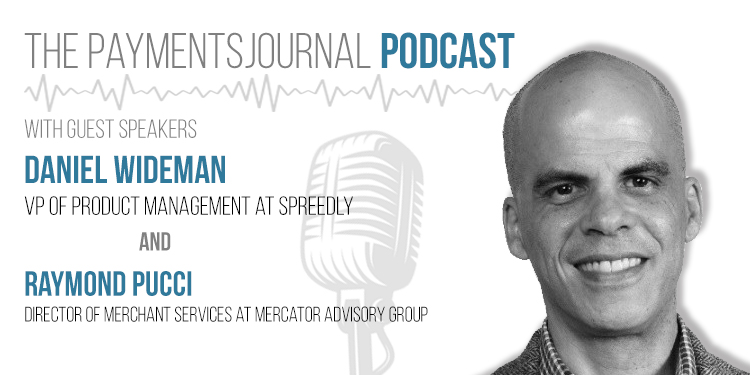Podcast: Play in new window | Download
Payment gateways have never been more popular than during COVID-19, and the size of the market is only growing as digital commerce accelerates. With grocery stores, sporting goods manufacturers, and home improvement retailers becoming more essential to the pandemic lifestyle, these, among other merchants, have added to the market size for payment gateways. As a result, online merchants are benefitting from the influx of gateways they can choose to work with.
To learn more about navigating the complexities of payments flows with the help of orchestration, and to discuss Mercator Advisory Group findings on what the crowded payment gateway landscape offers to online merchants PaymentsJournal sat down with Daniel Wideman, VP of Product Management at Spreedly, and Raymond Pucci, Director of Merchant Services at Mercator Advisory Group.
Platforms bring benefits to payments space
Platforms are pushing the payments envelope and services in exciting ways. They are rapidly adapting to this altered way of life, innovating new ways to make recurring online payments and members’ dues models, expanding delivery and order ahead services for restaurants, and even offering payment tools for digital publishers.
“I think what all these platforms have in common,” remarked Wideman, “is that they really allow merchants to focus their resources on the most important areas of business where they can add unique value.” To accelerate time to revenue for merchants, these platforms partner with other platforms that focus on non-core competency tasks.
Now, we’re seeing platforms that enable merchants to more quickly and easily meet new consumer demands for certain services, such as food delivery and home goods. “This is really rapidly moving from nice to have to urgently necessary,” said Wideman. Those that embrace a multi-provider strategy are positioning themselves to grow faster and with more efficiency when using a payments orchestration layer.
Platform business models and traditional merchants have different payment needs
Merchants are considered to be traditional B2B or B2C businesses, which operate as merchants of record. Merchants of records are businesses that are authorized and held liable by financial institutions to process customers’ card transactions. This differs from a platform, which usually automates a particular aspect of the business and serves as a layer between a merchant and customer.
Platforms are a group of with varying levels of payment, gateway relationships, preexisting vendor relationships, and sophistication. “Platforms are facing additional challenges around flexibility, choice, [and] supporting a wide range of payment providers.”
Payments flexibility is often seen as an important competitive differentiator, specifically platforms that operate as a two-sided marketplace. And with the global expansion of platform merchant databases, the industry wades into the territory of regional compliance, alternative payment methods, and data localizations.
“The difference in business models impact the relative importance and nature of their payment needs,” commented Wideman. For traditional merchants, “the needs range from basic payment enablement [to helping] offload regulatory compliance and reduc[ing] the burden of building and maintaining a payments infrastructure.” More sophisticated and advanced revenue optimization helps to improve success rates by reducing fees and costs and leveraging payments.
Payments orchestration addresses unique consumer needs
With the rapid advancement of new technologies in response to COVID-19 and the change in consumer spending habits, it is crucial for the payments industry to simplify the way it organizes data.
“Solving for merchant acquisition and time-to-value is one of the biggest challenges we’re hearing about from platforms, particularly as those merchants bring their own providers with them,” said Wideman. This means that the providers must continue to work together or risk losing a significant portion of the market. To do so, they have to design their platform in a way that allows for easy onboarding of merchants and gets them transacting quickly.
Payments orchestrations can help standardize and streamline this onboarding effort, granting merchants the flexibility to maintain relationships with current gateways while continuing to accept consumers’ payments of choice. This gives consumers the confidence in their payments platform’s ability to deliver services by the provider in a universal fashion. “That doesn’t constrain future shifts and choices the merchant may make to optimize their business model,” added Wideman, making orchestrations a best practice for optimizing success.
Takeaway
Payments orchestration is the key to merchant success now and in a post-COVID world.
COVID-19 has altered the payments industry, and there’s no going back. The pandemic has shifted the implementation of technology in online and point-of-sale payments from a convenience to a necessity.
Fortunately for merchants, they have a wide choice of payment gateway vendors in the U.S. market. While distinguishing among vendors can be difficult, orchestration companies allow for cross-platform gateway and payment service configuration, which creates more opportunities for growth.
Companies are positioned to grow even faster and more efficiently when they use a payments orchestration layer. “Valuable resources are really freed up to focus on customers’ needs [when implementing orchestration],” added Wideman. Orchestration layers make it possible for merchants and platforms to focus on customization and building an optimal stack of providers, technologies, and services, which will allow them to meet the personal requirements of each individual customer.
Orchestration is a valuable tool for integrating various providers and services. In the world that we live in today, “orchestration is not just nice to have, it’s a must have for rapid growth and expansion,” concluded Wideman.
